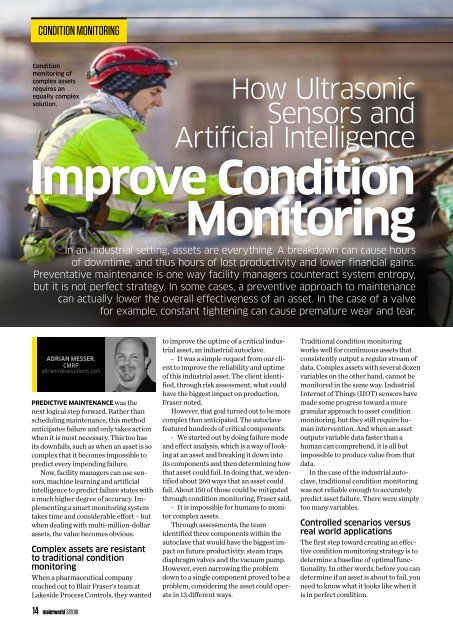Maintworld 3/2018
Are You Overlooking a Significant Source of Savings? // Advantages of broadband ultrasonic analysis // Are you in the “circle of despair”? // Future of work
Are You Overlooking a Significant Source
of Savings? // Advantages of broadband ultrasonic analysis // Are you in the “circle of despair”? // Future of work
You also want an ePaper? Increase the reach of your titles
YUMPU automatically turns print PDFs into web optimized ePapers that Google loves.
CONDITION MONITORING<br />
Condition<br />
monitoring of<br />
complex assets<br />
requires an<br />
equally complex<br />
solution.<br />
How Ultrasonic<br />
Sensors and<br />
Artificial Intelligence<br />
Improve Condition<br />
Monitoring<br />
In an industrial setting, assets are everything. A breakdown can cause hours<br />
of downtime, and thus hours of lost productivity and lower financial gains.<br />
Preventative maintenance is one way facility managers counteract system entropy,<br />
but it is not perfect strategy. In some cases, a preventive approach to maintenance<br />
can actually lower the overall effectiveness of an asset. In the case of a valve<br />
for example, constant tightening can cause premature wear and tear.<br />
Adrian Messer,<br />
CMRP<br />
adrianm@uesystems.com<br />
Predictive maintenance was the<br />
next logical step forward. Rather than<br />
scheduling maintenance, this method<br />
anticipates failure and only takes action<br />
when it is most necessary. This too has<br />
its downfalls, such as when an asset is so<br />
complex that it becomes impossible to<br />
predict every impending failure.<br />
Now, facility managers can use sensors,<br />
machine learning and artificial<br />
intelligence to predict failure states with<br />
a much higher degree of accuracy. Implementing<br />
a smart monitoring system<br />
takes time and considerable effort – but<br />
when dealing with multi-million-dollar<br />
assets, the value becomes obvious.<br />
Complex assets are resistant<br />
to traditional condition<br />
monitoring<br />
When a pharmaceutical company<br />
reached out to Blair Fraser's team at<br />
Lakeside Process Controls, they wanted<br />
14 maintworld 3/<strong>2018</strong><br />
to improve the uptime of a critical industrial<br />
asset, an industrial autoclave.<br />
- It was a simple request from our client<br />
to improve the reliability and uptime<br />
of this industrial asset. The client identified,<br />
through risk assessment, what could<br />
have the biggest impact on production,<br />
Fraser noted.<br />
However, that goal turned out to be more<br />
complex than anticipated. The autoclave<br />
featured hundreds of critical components.<br />
- We started out by doing failure mode<br />
and effect analysis, which is a way of looking<br />
at an asset and breaking it down into<br />
its components and then determining how<br />
that asset could fail. In doing that, we identified<br />
about 260 ways that an asset could<br />
fail. About 150 of those could be mitigated<br />
through condition monitoring, Fraser said.<br />
- It is impossible for humans to monitor<br />
complex assets.<br />
Through assessments, the team<br />
identified three components within the<br />
autoclave that would have the biggest impact<br />
on future productivity: steam traps,<br />
diaphragm valves and the vacuum pump.<br />
However, even narrowing the problem<br />
down to a single component proved to be a<br />
problem, considering the asset could operate<br />
in 13 different ways.<br />
Traditional condition monitoring<br />
works well for continuous assets that<br />
consistently output a regular stream of<br />
data. Complex assets with several dozen<br />
variables on the other hand, cannot be<br />
monitored in the same way. Industrial<br />
Internet of Things (IIOT) sensors have<br />
made some progress toward a more<br />
granular approach to asset condition<br />
monitoring, but they still require human<br />
intervention. And when an asset<br />
outputs variable data faster than a<br />
human can comprehend, it is all but<br />
impossible to produce value from that<br />
data.<br />
In the case of the industrial autoclave,<br />
traditional condition monitoring<br />
was not reliable enough to accurately<br />
predict asset failure. There were simply<br />
too many variables.<br />
Controlled scenarios versus<br />
real world applications<br />
The first step toward creating an effective<br />
condition monitoring strategy is to<br />
determine a baseline of optimal functionality.<br />
In other words, before you can<br />
determine if an asset is about to fail, you<br />
need to know what it looks like when it<br />
is in perfect condition.

















